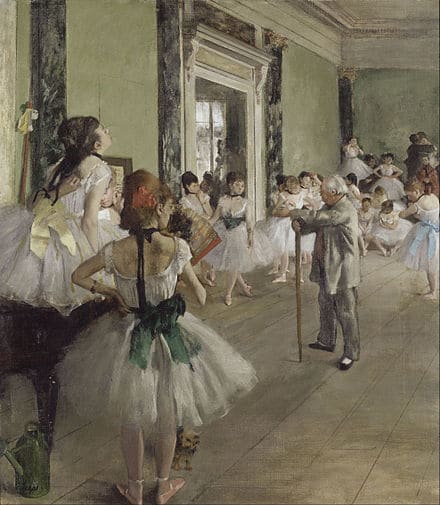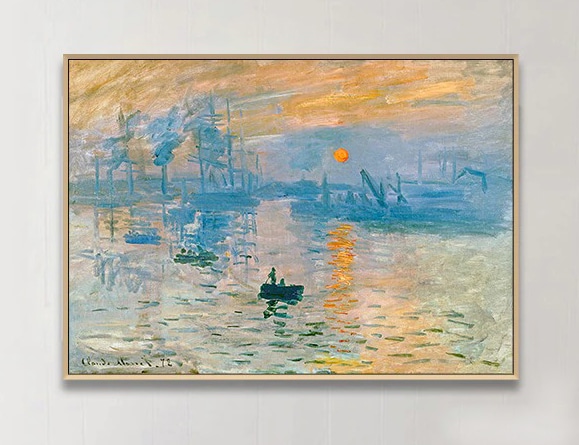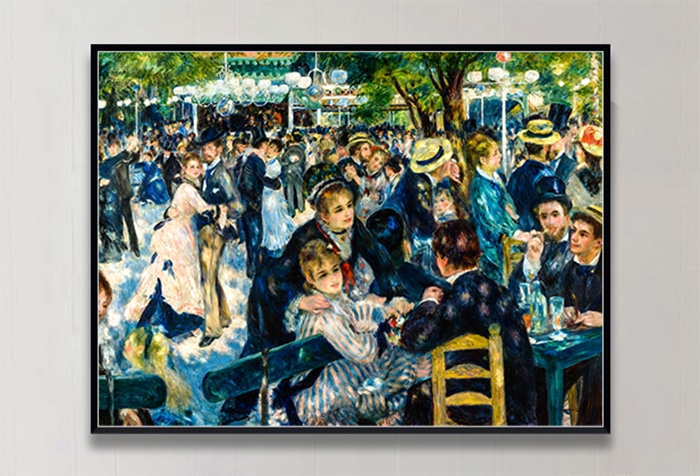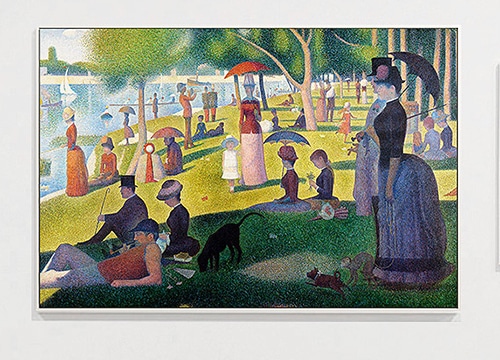Today, nobody questions the legitimacy of the famous impressionist paintings, but when first exhibited in 1874, they were regarded as unfinished, slapdash, and even renegade. What remains of their power and why do we love to have them hanging in our homes?

Impressionism Art Style – Shocking the Parisian Society
Unlike the studio-based approach that held sway at the annual Salons of the French Royal Academy whereby tonal gradations were gradually built up with layer upon layer, Impressionist paintings were oftentimes fully completed outdoors ‘en plein air’. However, landscapes and images from contemporary, everyday life were considered less important in the eyes of the Royal Academy, where ancient Greek and Roman art, historical mythological, and religious themes were more appreciated. According to the Salon, figures had to be strongly defined and arranged in harmonious compositions – a rule, that the Impressionists deliberately broke.
Impressionist Period: The first Exhibition and Reactions
“Is the absence of rules a good thing? Only the future will enlighten us…” (Emilie Cardon).
Review on the occasion of the first impressionist exhibition in 1874
The famous Impressionist painters who participated in the first Impressionist exhibition in 1874, tired of having their work rejected by the Salon, called themselves the Anonymous Society of Painters, Sculptors, and Printmakers. In their exhibition, there was neither a hierarchy of subject matter, state involvement, and jury, nor were they sharing a mission. Notwithstanding, most of the artists involved were painting scenes from modern lives, landscapes, and cityscapes, using wide palettes of colours, broken brushstrokes, and loosely defined forms, that gave the paintings the air of spontaneity.
They often showed city folks in the latest fashions or enjoying leisure activities in the Paris suburbs, unafraid to also show the new way of life, including the increased industrialization around them. Impressionists were obsessed with capturing the ephemeral effects of light, dappled, and filtered by trees, broken by clouds, or as reflections on the water. The Impressionism art style juxtaposed vivid complementary colours and bright pigments, that had recently become available, to paint objects as they appeared to be.
Art critic Louis Leory ridiculed the title of one of Claude Monet’s paintings on display “Impression Sunrise”, saying that it was only an impression and an unfinished sketch unsuitable for display. He named the show the “Exhibition of Impressionists” which was meant as an insult. However, the critic Jules Castagnary later put this name in a positive light, saying that “It is lively, brisk, light – captivating. What a rapid grasp of the object and what an amusing facture. It is summary, agreed, but how spot on the marks are!”
The members of the Impressionist artists group fluctuated with each exhibition. By 1886, Impressionism had become a global movement, with artists around the world exploring similar techniques, subject matter, and style. The Impressionist era became the foundation for post-impressionists and many other modernists movements to come.

Why we love the Impressionist Art Style Today
Impressionist artist were able to capture the world through their very own lenses. When looking at their pictures, you are aware of the person standing in front of the canvas, applying the paint mark by mark, from their own viewpoint in a very personal manner. It is here that we can see the beginnings of the prominence of the individual which has since taken hold and that is most exemplified today in our digital society, our thirst to share everyday views of the world from out personal angles in our own ways. It is this singular, subjective vision that Impressionism has come to embody.
The Impressionist art style is neither violent, distressing nor sentimental or moralistic. It is not dark and dramatic like the art that preceded it, nor is it confounding like some of the art that followed it. It simply is pleasant to look at with its recognizable subject matter rendered in a lively, invigorating way. The pictures are a visual delight, opening a window to an enthralling moment in time.
Impressionism was one of the first avant-garde art movements, each rejecting tradition and embracing the modern, promoting new ideas about what could be achieved by creating art. This vibe is present in every one of the Impressionist images. Putting up such images transfers this pleasing drive of insurrection right into our living spaces.
Claude Monet, Pierre-Auguste Renoir, and Georges Seurat are three of the most famous Impressionist painters. In the following we further investigate details and notable works of the Impressionist era.
Three most famous Impressionist paintings and the artists behind them
Claude Monet, Impression Sunrise

Claude Monet’s “Impression, Sunrise” was first shown at the first impressionist exhibition in 1874 and is credited to have inspired the name of the modernist art movement of Impressionism. Parisian art critiques faulted Monet’s painting technique for its unfinished appearance, the seemingly amateurish quality, for its light and loose brushwork, and his style of painting out of doors, en plein air.
In “Impression, Sunrise” Claude Monet depicts the port of Le Havre, his hometown in the Northwest of France. He most likely completed the picture in a single sitting on the spot, standing at a window overlooking the harbour at sunrise. It gives a suggestion of the early morning mist clogged with industrial smoke of the city. In his Impressionist landscape paintings, Monet stripped away the details to a bare minimum: the dockyards in the background are merely suggested by a few brushstrokes, as are the dark vessels which contrast against the hazy background, interspersed with orange and yellow hues of the red sun. More
Pierre-Auguste Renoir, Dance at Le Moulin de la Galette

French artist Pierre-Auguste Renoir is considered one of the leading painters in the development of the Impressionist style. In his pictures, he depicted the beauty and especially feminine sensuality. The painting “Dance at Le Moulin de la Galette” created 1876 is a seminal work of Renoir’s early maturity and widely celebrated as one of the important masterpieces of early Impressionism.
Capturing the vivacious and joyful atmosphere of the popular dance garden in Montmartre, Paris bathed in natural light was the artist’s main goal. Renoir chose an ordinary scene of the Parisians at leisure, during a typical Sunday afternoon at the Moulin de la Galette. In the late 19th century, working-class Parisians would dress up and enjoy spending time at this dance garden of Montmartre eating, drinking, and dancing till the evening. The “Dance the Le Moulin de la Galette” is a snapshot of real life, which is typical for the Impressionist art movement. It shows a richness in form, loose and fluid brushwork, capturing the flickering of the sun-dappled light. The personnel shown includes both regular patrons and some of Renoir’s preferred models.
The painting was Renoir’s most important work of the mid 1870’s and strongly influenced other avant-garde artists. More
Georges Seurat, A Sunday on La Grande Jatte

French artist Georges Seurat is one of the leading painters in the development of the post-Impressionist style. Today considered as his greatest work, “A Sunday Afternoon on the Island of la Grande Jatte” sparked public outrage and indignation due to the choice of the ‘vulgar’ topic and the artist’s mathematical and robotic interpretation of modernity in Paris. Notwithstanding, his style for which he tackled issues of form, colour, and light in an almost scientific manner, fascinated and inspired many fellow artists.
For Parisians, Sunday was the day to escape the summer heat of the city and seek the shade of the trees and the breeze of the River Seine. In his picture, Seurat shows the citizens relaxing in the suburban park on the island La Grande Jatte in the river. Among them are a fashionable dressed couple strolling across the lawn, to the left another well-dressed woman by the water, a small man with a black hat gazing at the river, a man playing the horn, and a woman knitting. Furthermore, there are two soldiers standing at attention and a man with a pipe and a couple with an infant child. Curiously, one lady is holding a monkey on a leash, a lady is fishing and another woman with a child staring directly at the viewer of the picture. More
These artists are considered the pioneers of Impressionism and Neo-Impressionism. Their works are timeless masterpieces and broke the conventions of art during the 19th Century. The question posed in the 1874 review of the first Impressionist exhibition “Is the absence of rules a good thing? Only the future will enlighten us…” can be clearly answered with: It does enlighten us, since it has demonstrated the spectrum of what the pursuit of singular vision can bring forth.
You might also enjoy reading the following posts by Pigment Pool:
Difference between Impressionism and Post-Impressionism: Art History Insights
Mandala and Meaning: The History and Significance of Mandalas
